Deck 27: Synthetic Polymers
Question
Question
Question
Question
Question
Question
Question
Question
Question
Question
Question
Question
Question
Question
Question
Question
Question
Question
Question
Question
Question
Question
Question
Question
Question
Question
Question
Question
Question
Question
Question
Question
Question
Question
Question
Question
Question
Question
Question
Question
Question
Question
Question
Question
Question
Question
Question
Question
Question
Question
Question
Question
Question
Question
Question
Question
Question
Question
Question
Question
Question
Question
Question
Question
Question
Question
Question
Question
Question
Question
Question
Question
Question
Question
Question
Question
Question
Question
Question
Question

Unlock Deck
Sign up to unlock the cards in this deck!
Unlock Deck
Unlock Deck
1/119
Play
Full screen (f)
Deck 27: Synthetic Polymers
1
Identify the polymer used in disposable cups.
A) polytetrafluoroethylene
B) polystyrene
C) polypropylene
D) polyethylene
E) poly(vinyl chloride)
A) polytetrafluoroethylene
B) polystyrene
C) polypropylene
D) polyethylene
E) poly(vinyl chloride)
polystyrene
2
Which one of the following is classified as a copolymer?
A) saran
B) polyacrylonitrile
C) poly(vinyl bromide)
D) polystyrene
E) polyethylene
A) saran
B) polyacrylonitrile
C) poly(vinyl bromide)
D) polystyrene
E) polyethylene
saran
3
Which one of the following monomers will produce polyisobutylene? 
A) I
B) II
C) III
D) IV
E) none of these

A) I
B) II
C) III
D) IV
E) none of these
II
4
A copolymer is a polymer constructed from ______.
A) a single type of monomer
B) two or more different types of monomers
C) monosaccharides
D) a dimer
E) a trimer
A) a single type of monomer
B) two or more different types of monomers
C) monosaccharides
D) a dimer
E) a trimer

Unlock Deck
Unlock for access to all 119 flashcards in this deck.
Unlock Deck
k this deck
5
Which one of the following is (are) a biopolymer?
A) RNA
B) DNA
C) polysaccharides
D) proteins
E) all of these
A) RNA
B) DNA
C) polysaccharides
D) proteins
E) all of these

Unlock Deck
Unlock for access to all 119 flashcards in this deck.
Unlock Deck
k this deck
6
A homopolymer is a polymer constructed from ______.
A) a single type of monomer
B) two different types of monomers
C) many different types of monomers
D) a dimer
E) a trimer
A) a single type of monomer
B) two different types of monomers
C) many different types of monomers
D) a dimer
E) a trimer

Unlock Deck
Unlock for access to all 119 flashcards in this deck.
Unlock Deck
k this deck
7
Which one of the following is the correct structure for polystyrene? 
A) I
B) II
C) III
D) IV
E) none of these

A) I
B) II
C) III
D) IV
E) none of these

Unlock Deck
Unlock for access to all 119 flashcards in this deck.
Unlock Deck
k this deck
8
Polymers are comprised of repeating units that are formed by joining _______.
A) tetramers
B) monomers
C) dimers
D) trimers
E) none of these
A) tetramers
B) monomers
C) dimers
D) trimers
E) none of these

Unlock Deck
Unlock for access to all 119 flashcards in this deck.
Unlock Deck
k this deck
9
Polymers constructed from a single type of monomer are called_______, where as those constructed from two or more different types of monomers are called________.
A) copolymers, homopolymers
B) homopolymers, copolymers
C) block polymers, homopolymers
D) homopolymers, block polymers
E) copolymers, block polymers
A) copolymers, homopolymers
B) homopolymers, copolymers
C) block polymers, homopolymers
D) homopolymers, block polymers
E) copolymers, block polymers

Unlock Deck
Unlock for access to all 119 flashcards in this deck.
Unlock Deck
k this deck
10
Which one of the following is classified as a homopolymer?
A) saran
B) viton
C) poly(vinyl bromide)
D) SAN
E) ABS
A) saran
B) viton
C) poly(vinyl bromide)
D) SAN
E) ABS

Unlock Deck
Unlock for access to all 119 flashcards in this deck.
Unlock Deck
k this deck
11
Which one of the following is the correct structure for poly(methyl -cyanoacrylate? 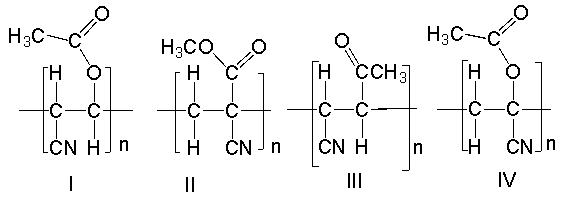
A) I
B) II
C) III
D) IV
E) none of these

A) I
B) II
C) III
D) IV
E) none of these

Unlock Deck
Unlock for access to all 119 flashcards in this deck.
Unlock Deck
k this deck
12
Which one of the following monomers will produce polyisoprene? 
A) I
B) II
C) III
D) IV
E) none of these

A) I
B) II
C) III
D) IV
E) none of these

Unlock Deck
Unlock for access to all 119 flashcards in this deck.
Unlock Deck
k this deck
13
Which one of the following monomers will produce poly(vinyl chloride)? 
A) I
B) II
C) III
D) IV
E) none of these

A) I
B) II
C) III
D) IV
E) none of these

Unlock Deck
Unlock for access to all 119 flashcards in this deck.
Unlock Deck
k this deck
14
Which one of the following is not a biopolymer?
A) amylopectin
B) DNA
C) glycogen
D) chitin
E) none of these
A) amylopectin
B) DNA
C) glycogen
D) chitin
E) none of these

Unlock Deck
Unlock for access to all 119 flashcards in this deck.
Unlock Deck
k this deck
15
Which one of the following is the correct structure for poly(vinyl acetate)? 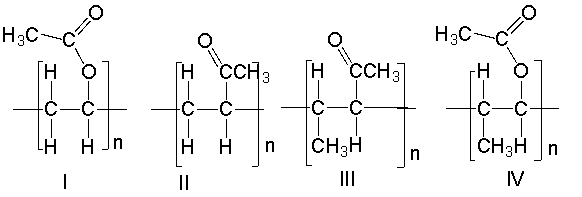
A) I
B) II
C) III
D) IV
E) none of these

A) I
B) II
C) III
D) IV
E) none of these

Unlock Deck
Unlock for access to all 119 flashcards in this deck.
Unlock Deck
k this deck
16
Which one of the following monomers will produce polytetrafluoroethylene? 
A) I
B) II
C) III
D) IV
E) none of these

A) I
B) II
C) III
D) IV
E) none of these

Unlock Deck
Unlock for access to all 119 flashcards in this deck.
Unlock Deck
k this deck
17
Identify the polymer used in nonstick frying pans.
A) polytetrafluoroethylene
B) polystyrene
C) polypropylene
D) polyethylene
E) poly(vinyl chloride)
A) polytetrafluoroethylene
B) polystyrene
C) polypropylene
D) polyethylene
E) poly(vinyl chloride)

Unlock Deck
Unlock for access to all 119 flashcards in this deck.
Unlock Deck
k this deck
18
Identify the polymer used in plumbing.
A) polytetrafluoroethylene
B) polystyrene
C) polypropylene
D) polyethylene
E) poly(vinyl chloride)
A) polytetrafluoroethylene
B) polystyrene
C) polypropylene
D) polyethylene
E) poly(vinyl chloride)

Unlock Deck
Unlock for access to all 119 flashcards in this deck.
Unlock Deck
k this deck
19
Which one of the following is the correct structure for poly(vinylidene fluoride)? 
A) I
B) II
C) III
D) IV
E) none of these

A) I
B) II
C) III
D) IV
E) none of these

Unlock Deck
Unlock for access to all 119 flashcards in this deck.
Unlock Deck
k this deck
20
Identify the polymer used in food packaging.
A) SAN
B) ABS
C) butyl rubber
D) viton
E) saran
A) SAN
B) ABS
C) butyl rubber
D) viton
E) saran

Unlock Deck
Unlock for access to all 119 flashcards in this deck.
Unlock Deck
k this deck
21
Which of the following monomers would be most reactive towards cationic polymerization? 
A) I
B) II
C) III
D) IV
E) V

A) I
B) II
C) III
D) IV
E) V

Unlock Deck
Unlock for access to all 119 flashcards in this deck.
Unlock Deck
k this deck
22
Which of the following monomers would be most reactive towards anionic polymerization? 
A) I
B) II
C) III
D) IV
E) V

A) I
B) II
C) III
D) IV
E) V

Unlock Deck
Unlock for access to all 119 flashcards in this deck.
Unlock Deck
k this deck
23
PET, used to make soft-drink bottles, is classified as a(n) __________.
A) homopolymer
B) block copolymer
C) graft copolymer
D) alternating copolymer
E) random copolymer
A) homopolymer
B) block copolymer
C) graft copolymer
D) alternating copolymer
E) random copolymer

Unlock Deck
Unlock for access to all 119 flashcards in this deck.
Unlock Deck
k this deck
24
Which of the following monomer(s) is(are) required to make the polymer below? 
A) propene
B) isobutylene
C) isoprene
D) styrene
E) none of these

A) propene
B) isobutylene
C) isoprene
D) styrene
E) none of these

Unlock Deck
Unlock for access to all 119 flashcards in this deck.
Unlock Deck
k this deck
25
Which of the following is used as an initiator in cationic polymerization?
A) BF3, H2O
B) CH3CH2CH2CH2Li
C) ROOR
D) NaOH
E) none of these
A) BF3, H2O
B) CH3CH2CH2CH2Li
C) ROOR
D) NaOH
E) none of these

Unlock Deck
Unlock for access to all 119 flashcards in this deck.
Unlock Deck
k this deck
26
The following polymer is classified as a(n) ________. 
A) homopolymer
B) block copolymer
C) graft copolymer
D) alternating copolymer
E) random copolymer

A) homopolymer
B) block copolymer
C) graft copolymer
D) alternating copolymer
E) random copolymer

Unlock Deck
Unlock for access to all 119 flashcards in this deck.
Unlock Deck
k this deck
27
Provide the structure of a region of an alternating copolymer constructed from propylene and acrylonitrile.

Unlock Deck
Unlock for access to all 119 flashcards in this deck.
Unlock Deck
k this deck
28
Which of the following is a region of a block copolymer constructed from isobutylene and vinyl fluoride? 



A) I
B) II
C) III
D) IV
E) none of these




A) I
B) II
C) III
D) IV
E) none of these

Unlock Deck
Unlock for access to all 119 flashcards in this deck.
Unlock Deck
k this deck
29
Provide the structure of a region of a random copolymer constructed from ethylene and styrene.

Unlock Deck
Unlock for access to all 119 flashcards in this deck.
Unlock Deck
k this deck
30
The following polymer is classified as a(n) ________. 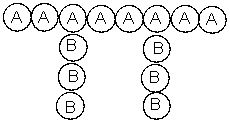
A) homopolymer
B) block copolymer
C) graft copolymer
D) alternating copolymer
E) random copolymer

A) homopolymer
B) block copolymer
C) graft copolymer
D) alternating copolymer
E) random copolymer

Unlock Deck
Unlock for access to all 119 flashcards in this deck.
Unlock Deck
k this deck
31
Which of the following monomer pairs is required to make the polymer below? 
A) propene and acrylonitrile
B) isoprene and acrylonitrile
C) ethylene and acrylonitrile
D) isobutylene and acrylonitrile
E) none of these

A) propene and acrylonitrile
B) isoprene and acrylonitrile
C) ethylene and acrylonitrile
D) isobutylene and acrylonitrile
E) none of these

Unlock Deck
Unlock for access to all 119 flashcards in this deck.
Unlock Deck
k this deck
32
Which of the following is used as an initiator in anionic polymerization?
A) BF3, H2O
B) CH3CH2CH2CH2Li
C) ROOR
D) H2SO4
E) none of these
A) BF3, H2O
B) CH3CH2CH2CH2Li
C) ROOR
D) H2SO4
E) none of these

Unlock Deck
Unlock for access to all 119 flashcards in this deck.
Unlock Deck
k this deck
33
Which of the following monomer pairs is required to make the polymer below? 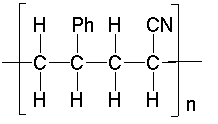
A) styrene and acrylonitrile
B) styrene and propylnitrile
C) phenylpropene and acrylonitrile
D) phenylpropene and propylnitrile
E) none of these

A) styrene and acrylonitrile
B) styrene and propylnitrile
C) phenylpropene and acrylonitrile
D) phenylpropene and propylnitrile
E) none of these

Unlock Deck
Unlock for access to all 119 flashcards in this deck.
Unlock Deck
k this deck
34
The following polymer is classified as a(n) ________. 
A) homopolymer
B) block copolymer
C) graft copolymer
D) alternating copolymer
E) random copolymer

A) homopolymer
B) block copolymer
C) graft copolymer
D) alternating copolymer
E) random copolymer

Unlock Deck
Unlock for access to all 119 flashcards in this deck.
Unlock Deck
k this deck
35
Provide the structure of a region of a block copolymer constructed from isobutylene and vinyl fluoride.

Unlock Deck
Unlock for access to all 119 flashcards in this deck.
Unlock Deck
k this deck
36
The following polymer is classified as a(n) ________. 
A) homopolymer
B) block copolymer
C) graft copolymer
D) alternating copolymer
E) random copolymer

A) homopolymer
B) block copolymer
C) graft copolymer
D) alternating copolymer
E) random copolymer

Unlock Deck
Unlock for access to all 119 flashcards in this deck.
Unlock Deck
k this deck
37
Which of the following is a region of a random copolymer constructed from isobutylene and vinyl fluoride? 



A) I
B) II
C) III
D) IV
E) none of these




A) I
B) II
C) III
D) IV
E) none of these

Unlock Deck
Unlock for access to all 119 flashcards in this deck.
Unlock Deck
k this deck
38
Which of the following monomer pairs is required to make the polymer below? 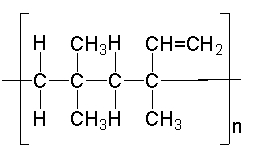
A) propene and isobutylene
B) isoprene and propene
C) ethylene and butene
D) isobutylene and isoprene
E) none of these

A) propene and isobutylene
B) isoprene and propene
C) ethylene and butene
D) isobutylene and isoprene
E) none of these

Unlock Deck
Unlock for access to all 119 flashcards in this deck.
Unlock Deck
k this deck
39
Which of the following is a region of an alternate copolymer constructed from isobutylene and vinyl fluoride? 



A) I
B) II
C) III
D) IV
E) none of these




A) I
B) II
C) III
D) IV
E) none of these

Unlock Deck
Unlock for access to all 119 flashcards in this deck.
Unlock Deck
k this deck
40
Which of the following is used as an initiator in radical polymerization?
A) BF3, H2O
B) CH3CH2CH2CH2Li
C) ROOR
D) NaOH
E) H2O
A) BF3, H2O
B) CH3CH2CH2CH2Li
C) ROOR
D) NaOH
E) H2O

Unlock Deck
Unlock for access to all 119 flashcards in this deck.
Unlock Deck
k this deck
41
Provide the structure of a region of the polymer that is produced when phosgene is treated with 3,3-dimethyl-1,5-pentanediol.

Unlock Deck
Unlock for access to all 119 flashcards in this deck.
Unlock Deck
k this deck
42
Provide the structure of the monomer(s) that would produce the following condensation polymer. 


Unlock Deck
Unlock for access to all 119 flashcards in this deck.
Unlock Deck
k this deck
43
Arrange the following monomers in decreasing order of reactivity towards cationic polymerization? 
A) I > III > II
B) II > I > III
C) III > II > I
D) II > III > I
E) III > I > II

A) I > III > II
B) II > I > III
C) III > II > I
D) II > III > I
E) III > I > II

Unlock Deck
Unlock for access to all 119 flashcards in this deck.
Unlock Deck
k this deck
44
Provide the structure of a region of the polymer that is produced when the following monomers are treated in the presence of dilute NaOH. 


Unlock Deck
Unlock for access to all 119 flashcards in this deck.
Unlock Deck
k this deck
45
Which of the following polymers would be best prepared using cationic polymerization? 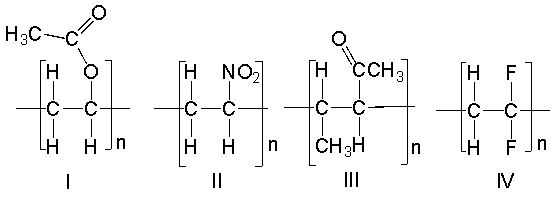
A) I
B) II
C) III
D) IV
E) none of these

A) I
B) II
C) III
D) IV
E) none of these

Unlock Deck
Unlock for access to all 119 flashcards in this deck.
Unlock Deck
k this deck
46
Provide the structure of the monomer(s) that would produce the following condensation polymer. 


Unlock Deck
Unlock for access to all 119 flashcards in this deck.
Unlock Deck
k this deck
47
Provide the structure of a region of the polymer that is produced when the following monomers react. 


Unlock Deck
Unlock for access to all 119 flashcards in this deck.
Unlock Deck
k this deck
48
Which of the following monomer(s) would undergo cationic polymerization?
A. vinylidene fluoride
B. acrylonitrile
C. isobutylene
D. vinyl acetate
E. all of these
A. vinylidene fluoride
B. acrylonitrile
C. isobutylene
D. vinyl acetate
E. all of these

Unlock Deck
Unlock for access to all 119 flashcards in this deck.
Unlock Deck
k this deck
49
Which of the following polymers would be best prepared using anionic polymerization? 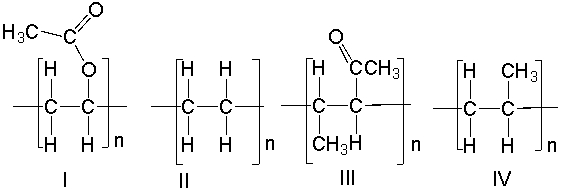
A) I
B) II
C) III
D) IV
E) none of these

A) I
B) II
C) III
D) IV
E) none of these

Unlock Deck
Unlock for access to all 119 flashcards in this deck.
Unlock Deck
k this deck
50
Provide the structure of monomer(s) that would produce the following condensation polymer. 


Unlock Deck
Unlock for access to all 119 flashcards in this deck.
Unlock Deck
k this deck
51
Which of the following monomers would produce the condensation polymer below? 

A) I
B) II
C) III
D) IV
E) C and D


A) I
B) II
C) III
D) IV
E) C and D

Unlock Deck
Unlock for access to all 119 flashcards in this deck.
Unlock Deck
k this deck
52
Arrange the following monomers in decreasing order of reactivity towards anionic polymerization? 
A) I > III > II
B) II > I > III
C) III > II > I
D) II > III > I
E) III > I > II

A) I > III > II
B) II > I > III
C) III > II > I
D) II > III > I
E) III > I > II

Unlock Deck
Unlock for access to all 119 flashcards in this deck.
Unlock Deck
k this deck
53
Which of the following monomer(s) would undergo anionic polymerization?
A) vinyl acetate
B) acrylonitrile
C) isobutylene
D) vinylidene chloride
E) all of these
A) vinyl acetate
B) acrylonitrile
C) isobutylene
D) vinylidene chloride
E) all of these

Unlock Deck
Unlock for access to all 119 flashcards in this deck.
Unlock Deck
k this deck
54
Which of the following monomer(s) would undergo both radical and cationic polymerization?
A) methyl methacrylate
B) acrylonitrile
C) isobutylene
D) vinylidene chloride
E) all of these
A) methyl methacrylate
B) acrylonitrile
C) isobutylene
D) vinylidene chloride
E) all of these

Unlock Deck
Unlock for access to all 119 flashcards in this deck.
Unlock Deck
k this deck
55
Which of the following is (are) condensation polymer(s)?
A) nylon 6,6
B) polyisobutylene
C) poly(vinyl chloride)
D) polycarbonate
E) A and D
A) nylon 6,6
B) polyisobutylene
C) poly(vinyl chloride)
D) polycarbonate
E) A and D

Unlock Deck
Unlock for access to all 119 flashcards in this deck.
Unlock Deck
k this deck
56
Which of the following monomers would produce the condensation polymer below? 

A) I
B) II
C) III
D) IV
E) C and D


A) I
B) II
C) III
D) IV
E) C and D

Unlock Deck
Unlock for access to all 119 flashcards in this deck.
Unlock Deck
k this deck
57
Arrange the following monomers in decreasing order of reactivity towards anionic polymerization? 
A) I > III > II
B) II > III > I
C) III > II > I
D) II > I > III
E) III > I > II

A) I > III > II
B) II > III > I
C) III > II > I
D) II > I > III
E) III > I > II

Unlock Deck
Unlock for access to all 119 flashcards in this deck.
Unlock Deck
k this deck
58
Nomex is a synthetic polymer with the following structure. Provide the structure(s) of the monomer(s) that would produce Nomex. 


Unlock Deck
Unlock for access to all 119 flashcards in this deck.
Unlock Deck
k this deck
59
_________ polymerization usually forms living polymers if the process is not terminated by an electrophile.
A) anionic
B) cationic
C) radical
D) condensation
E) elimination
A) anionic
B) cationic
C) radical
D) condensation
E) elimination

Unlock Deck
Unlock for access to all 119 flashcards in this deck.
Unlock Deck
k this deck
60
Identify the type of addition that is used to form Superglue.
A) anionic
B) cationic
C) radical
D) condensation
E) elimination
A) anionic
B) cationic
C) radical
D) condensation
E) elimination

Unlock Deck
Unlock for access to all 119 flashcards in this deck.
Unlock Deck
k this deck
61
Which of the following polymerization processes best describes the formation of polyisobutylene?
A) step growth addition
B) chain growth addition
C) step growth condensation
D) chain growth condensation
E) none of these
A) step growth addition
B) chain growth addition
C) step growth condensation
D) chain growth condensation
E) none of these

Unlock Deck
Unlock for access to all 119 flashcards in this deck.
Unlock Deck
k this deck
62
What is the classification of the following polymer? 
A) polyester
B) polyamide
C) polyurethane
D) polycarbonate
E) none of these

A) polyester
B) polyamide
C) polyurethane
D) polycarbonate
E) none of these

Unlock Deck
Unlock for access to all 119 flashcards in this deck.
Unlock Deck
k this deck
63
Which of the following are examples of step growth polymerization?
A) radical polymerization
B) cationic polymerization
C) anionic polymerization
D) condensation polymerization
E) none of these
A) radical polymerization
B) cationic polymerization
C) anionic polymerization
D) condensation polymerization
E) none of these

Unlock Deck
Unlock for access to all 119 flashcards in this deck.
Unlock Deck
k this deck
64
Provide the structure of a region of the polymer that is produced when the following isocyanate is treated with 1,4-butanediol. 


Unlock Deck
Unlock for access to all 119 flashcards in this deck.
Unlock Deck
k this deck
65
What is not an example of a small molecule that is released in a condensation reaction?
A) water
B) carbon dioxide
C) nitrogen gas
D) benzene
A) water
B) carbon dioxide
C) nitrogen gas
D) benzene

Unlock Deck
Unlock for access to all 119 flashcards in this deck.
Unlock Deck
k this deck
66
Provide the monomer(s) that would produce the following polymer? 


Unlock Deck
Unlock for access to all 119 flashcards in this deck.
Unlock Deck
k this deck
67
What are the monomers in a polyurethane?
A) isocyanate and alcohol
B) diisocyanate and diol
C) ester and amine
D) carboxylic acid and amine
E) amide and alcohol
A) isocyanate and alcohol
B) diisocyanate and diol
C) ester and amine
D) carboxylic acid and amine
E) amide and alcohol

Unlock Deck
Unlock for access to all 119 flashcards in this deck.
Unlock Deck
k this deck
68
Identify the polymer that is used in rope.
A) Nylon 6
B) Teflon
C) Kevlar
D) Lexan
E) Nylon 6,6
A) Nylon 6
B) Teflon
C) Kevlar
D) Lexan
E) Nylon 6,6

Unlock Deck
Unlock for access to all 119 flashcards in this deck.
Unlock Deck
k this deck
69
Which of the following polymerization processes best describes the formation of polyurethanes?
A) step growth addition
B) chain growth addition
C) step growth condensation
D) chain growth condensation
E) none of these
A) step growth addition
B) chain growth addition
C) step growth condensation
D) chain growth condensation
E) none of these

Unlock Deck
Unlock for access to all 119 flashcards in this deck.
Unlock Deck
k this deck
70
Give the monomers to form PET.

Unlock Deck
Unlock for access to all 119 flashcards in this deck.
Unlock Deck
k this deck
71
Identify the polymer that is used in bullet-proof vests.
A) Nylon 6
B) Teflon
C) Kevlar
D) Lexan
E) Nylon 6,6
A) Nylon 6
B) Teflon
C) Kevlar
D) Lexan
E) Nylon 6,6

Unlock Deck
Unlock for access to all 119 flashcards in this deck.
Unlock Deck
k this deck
72
_______ polymers are formed under conditions in which the individual monomers react with each other to form oligomers, which are then joined to form polymers.
A) Step growth
B) Chain growth
C) Branched
D) Graft
E) none of these
A) Step growth
B) Chain growth
C) Branched
D) Graft
E) none of these

Unlock Deck
Unlock for access to all 119 flashcards in this deck.
Unlock Deck
k this deck
73
Identify the type of compound used to make safety goggles.
A) polyester
B) polyamide
C) polyether
D) polyalcohol
E) polycarbonate
A) polyester
B) polyamide
C) polyether
D) polyalcohol
E) polycarbonate

Unlock Deck
Unlock for access to all 119 flashcards in this deck.
Unlock Deck
k this deck
74
Give the monomers to form Nylon 6,6.

Unlock Deck
Unlock for access to all 119 flashcards in this deck.
Unlock Deck
k this deck
75
Which of the following best describes the polymer shown below? 
A) atactic
B) isotactic
C) syndiotactic
D) antidiotactic
E) none of these

A) atactic
B) isotactic
C) syndiotactic
D) antidiotactic
E) none of these

Unlock Deck
Unlock for access to all 119 flashcards in this deck.
Unlock Deck
k this deck
76
Identify the polymer that is used in bicycle helmets.
A) Nylon 6
B) Teflon
C) Kevlar
D) Lexan
E) Nylon 6,6
A) Nylon 6
B) Teflon
C) Kevlar
D) Lexan
E) Nylon 6,6

Unlock Deck
Unlock for access to all 119 flashcards in this deck.
Unlock Deck
k this deck
77
Which of the following statements is (are) true about linear polymers?
A) they are highly branched
B) they may be slightly branched
C) they can have no branching
D) A and B
E) B and C
A) they are highly branched
B) they may be slightly branched
C) they can have no branching
D) A and B
E) B and C

Unlock Deck
Unlock for access to all 119 flashcards in this deck.
Unlock Deck
k this deck
78
Which of the following polymerization processes best describes the formation of polycarbonates?
A) step growth addition
B) chain growth addition
C) step growth condensation
D) chain growth condensation
E) none of these
A) step growth addition
B) chain growth addition
C) step growth condensation
D) chain growth condensation
E) none of these

Unlock Deck
Unlock for access to all 119 flashcards in this deck.
Unlock Deck
k this deck
79
Which of the following are examples of chain growth polymerization?
A) radical polymerization
B) cationic polymerization
C) anionic polymerization
D) condensation polymerization
E) A, B and C
A) radical polymerization
B) cationic polymerization
C) anionic polymerization
D) condensation polymerization
E) A, B and C

Unlock Deck
Unlock for access to all 119 flashcards in this deck.
Unlock Deck
k this deck
80
Give the monomers to form Lexan.

Unlock Deck
Unlock for access to all 119 flashcards in this deck.
Unlock Deck
k this deck



